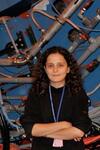Savil Salur
Strongly interacting, high density matter is produced in heavy ion collisions at the Relativistic Heavy Ion Collider (RHIC). Hadronic resonances, due to their short lifetimes, can be used to investigate the freeze-out mechanisms after hadronization. The production of the strange baryonic resonance Σ*(1385) is investigated for the first time in heavy ion collisions and, through comparison with other resonances, the evolution of the fireball is investigated.
The data used for the analyses in this thesis were taken with the Solenoidal Tracker at RHIC (STAR) detector. Measurements of Σ*(1385), through the hadronic decay channel Σ*(1385)± →Λ + π±, in the 0-5% most central Au+Au and minimum bias p+p and d+Au collisions are presented. The invariant mass spectra of the Σ*(1385) are reconstructed using a combinatorial technique, and a mixed-event technique is applied to estimate the uncorrelated background. The corrected pT spectra, inverse slope parameters, and yields of the Σ(1385)± and their antiparticles are measured and compared. The 〈pT〉 measurements of the Σ*(1385) is compared to those of other heavy particles to investigate effects of radial flow and particle production mechanisms. The Σ*(1385)/Λ ratio, along with other resonance to stable particle ratios, suggests that a regeneration mechanism recovers signal loss due to re-scattering in the final state in Au+Au collisions. The nuclear modification factors, RdAu and RAA for Σ*(1385) are studied in comparison to those stable particles.
It has been hypothesized that pentaquarks, consisting of various combinations of five light u, d, and s quarks, may be produced in the high density collisions occurring at RHIC. Simulation studies and improved resonance identification techniques are used to search for pentaquarks.
